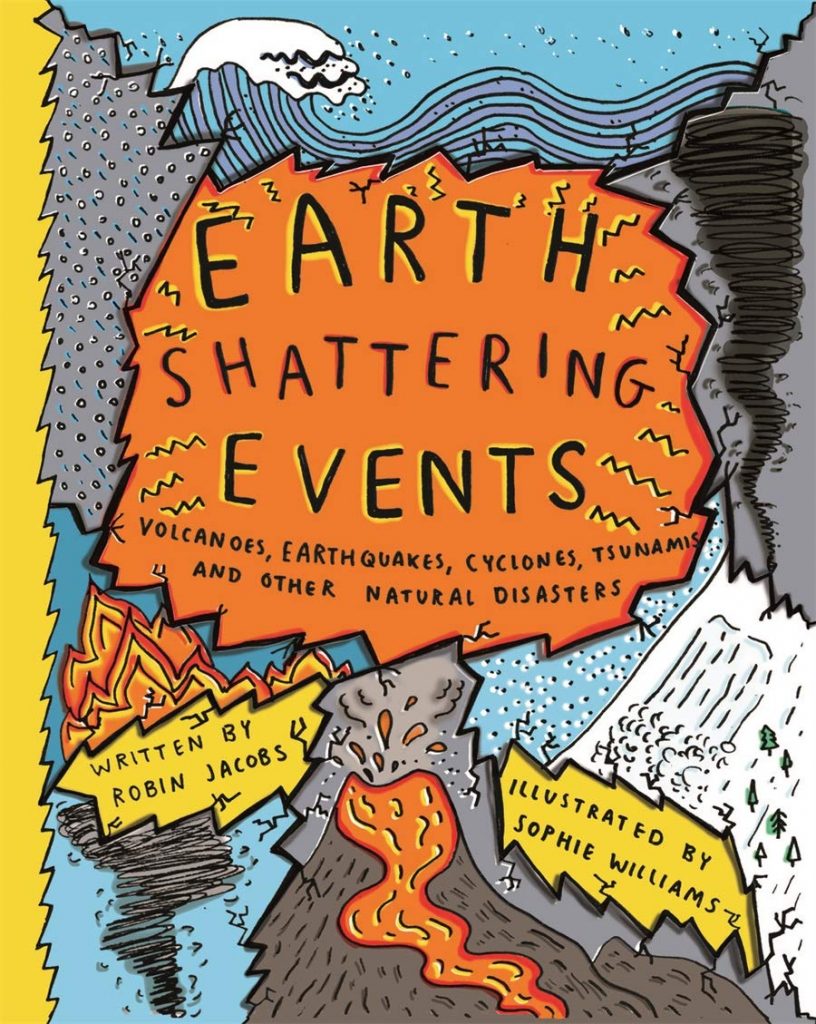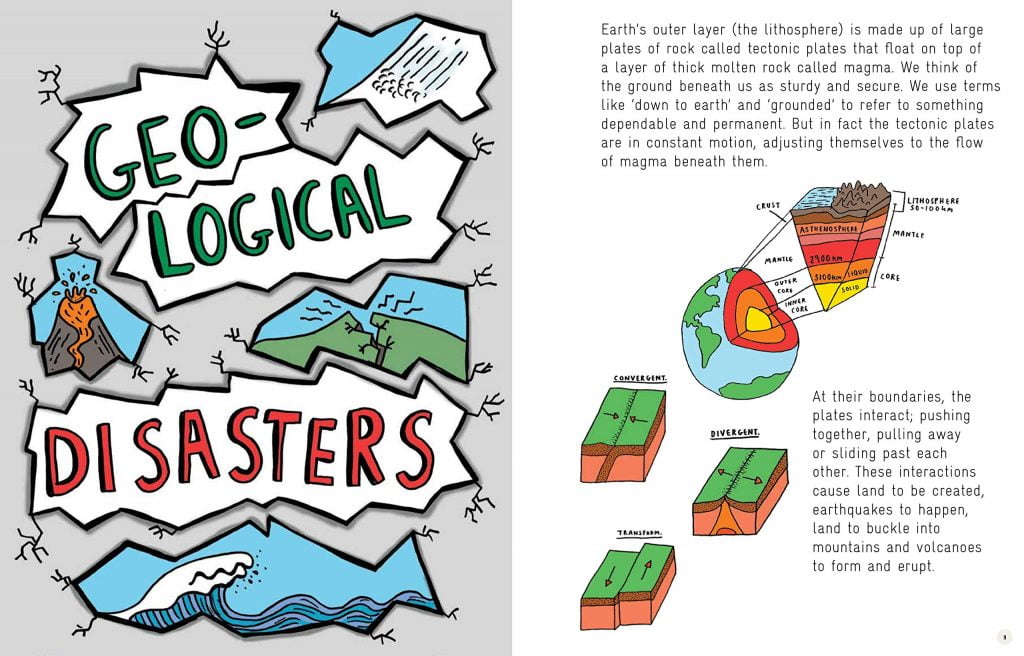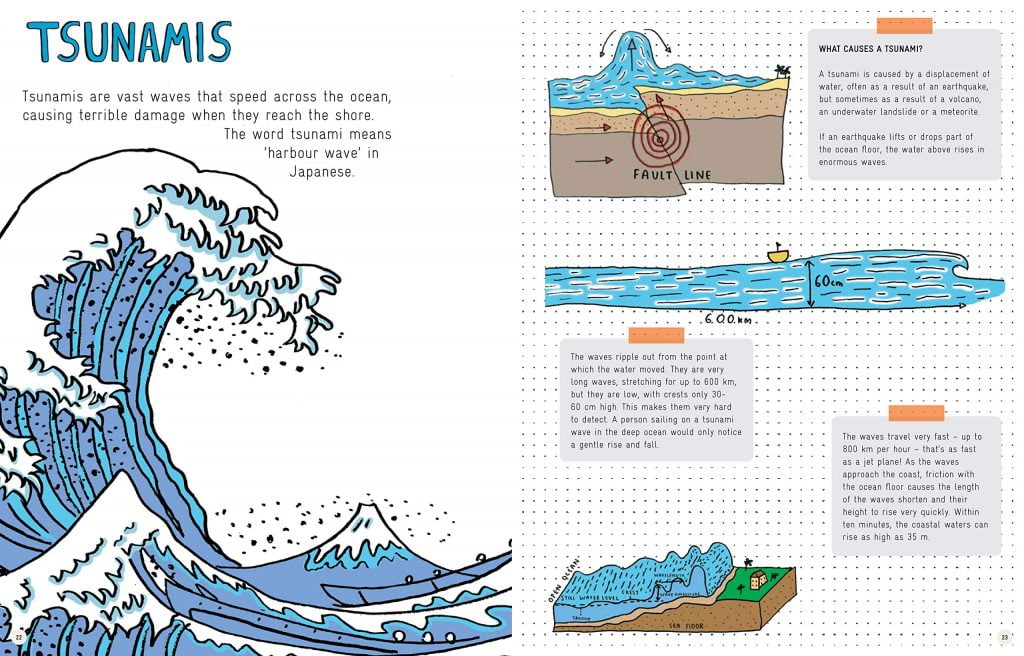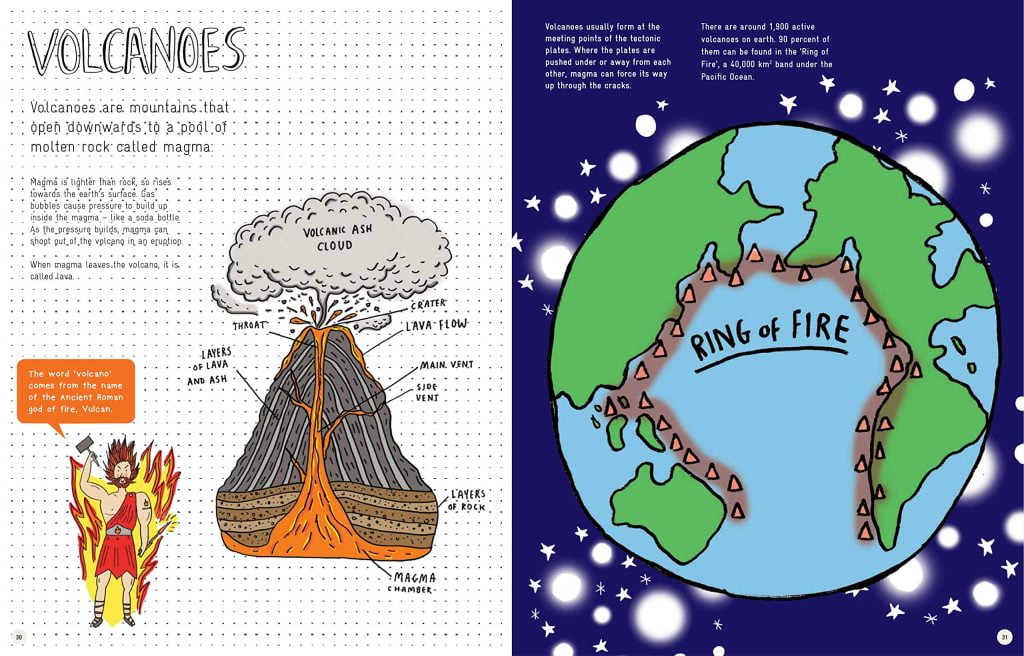Today we talk to Sophie Williams and Robin Jacobs about volcanoes, earthquakes, tsunamis, and how they worked together to create their brand-new, engaging geography book EARTH-SHATTERING EVENTS, which manages to be accessible, fun and informative!
Without giving too much away, can you tell us about your book Earth-Shattering Events?
ROBIN: It’s a look at the science behind natural disasters, including volcanoes, earthquakes, tsunamis, cyclones and tornadoes. We look at why these things happen, what the impacts are and what to do if you have the misfortune to get caught in one!
SOPHIE: It’s a book that will tell you everything you need to know about natural disasters. Each section guides the reader through a different disaster, explaining the details, variations and what do to in the worst case scenario. The information is laid out in a fun and easy to understand way, making this heavy subject matter accessible for all ages!
What I think the book does particularly well is simplify and explain some complicated ideas for children. How difficult was it to do this and how important were the illustrations in achieving this?
ROBIN: It’s something that I had to work really hard at. I have a degree in earth sciences, but even I found some of the scientific explanations hard to wrap my head around. I had a really good advisor alongside to help me out, and then it was a matter of making sure the facts were there in their clearest and simplest form. Working alongside Sophie was a godsend, because some of the elements we were describing are actually much more clearly conveyed in pictures. Sophie has such a good tone to her drawings – they’re fun but they’re so informative as well.
SOPHIE: It was really important to me to make sure my illustrations conveyed the information efficiently but remained fun and engaging for children. I did a lot of research for each drawing and I learnt so much during the process! My illustrations have an almost cartoon-like quality, which I think helps to simplify the science heavy facts in this book, and also make the horror of natural disasters seem a bit less shocking. Through the mix of illustrated characters, landscapes and scientific diagrams I think we got the balance just right.
Is this an area of the natural world that has always interested you? What sort of research did you carry out while writing the book?
ROBIN: Although I currently work in the world of publishing, geography has always been a passion of mine and I studied it at undergraduate degree. With the world in the state that it’s in, my interest borders on the obsessive, so I am constantly reading articles in print and online. In that respect it was very easy to pull together the material I needed to write the book. In a way the challenge was not to over research and over complicate.
Sophie, I wondered how involved you were in the actual design and layout of the book? Do you pass your illustrations on to a team who then decide on where they’re placed, for example?
SOPHIE: I was working with a designer, Lisa. My illustrations were passed on to her and she would lay them out and was responsible for the overall design of the book. It took quite a lot of back and forth between us to get things right, especially in the early stages as the book was beginning to take shape. Sometimes I would need to add in extra illustrations or resize current ones to fit the layout of the page properly. There were also a few pages that were fully illustrated, such as the introduction and contents page, in which case the design and layout would be up to me.
I wondered what the process was like for you both working on this? I know, for example, that the writer of a picture book doesn’t always get involved with the illustration side of things, but the text and artwork work so well together in this book that it seems like you needed to work quite closely together?
ROBIN: Yes it was a very collaborative process. I worked as the editor of the book as well as the writer, so as I would work up the text and then tell Sophie which bits needed illustrations attached. At first I was a bit sceptical – volcanoes was the first chapter that we did and I thought ‘how is she going to draw five volcanoes that look different from one another’ – but she’s great at researching before she starts drawing and somehow each volcano really looks like the volcano it’s supposed to look like! The designer, Lisa, also helped out. She would tell us where pages were looking a bit empty and we would add in extra visual material there.
SOPHIE: It was a definitely a team effort, I would receive a document of text for each section of the book and each important piece of information would be broken down into an illustration. I would be constantly sending over my illustrations to Robin and Lisa. Often illustrations would need to be edited, extra images would be needed and bits of text would need to be handwritten to make the book flow and for the text and illustrations to work together.
Do you have a favourite interesting fact or piece of information?
ROBIN: A tsunami starts off as a very low but very long wave. Its crest is only around 40cm high. It’s only when it hits the shore and concertinas up that it becomes a mega-wave.
Do you have a favourite illustration in the book? Why is it your favourite?
SOPHIE: I particularly love the volcano illustrations that are featured on the map of the world. These were the first illustrations I completed for the book! I remember feeling really happy with them and this made me feel confident that my illustration style was right for this book. This was my first non-fiction publication so it was really exciting to see that my work could be used in such an informative way. I also have a soft spot for Numazu, the earthquake starting catfish!
Do you have any ideas or suggestions about how the book might be used in classrooms?
ROBIN: I think it’s very important to teach children to respect our planet, and having a sense of the power of nature could be a good launchpad from which to talk about other environmental issues. Besides, I find that kids are often enthralled by the thought of something even more powerful than grownups! We’ve made some information sheets for teachers to use.
SOPHIE: I think getting the kids to read this book in the classroom will make them excited about to learn some of the wonders of our planet and hopefully help them to understand and respect nature! Having a physical book to interact with is great for engagement and hopefully the bright illustrations and characters will keep them interested. Teachers could potentially use each different chapter as a different lesson, maybe the children could quiz each other and all the interesting facts they’ve learned or make a poster/presentation on their chosen natural disaster. The final chapter, climate change is particularly relevant and important for children to lean about and begin to understand form an early age.
Finally, can you describe Earth-Shattering Events in three words?
ROBIN: Informative, illustrative, impactful
SOPHIE: Exciting, educational, engaging





